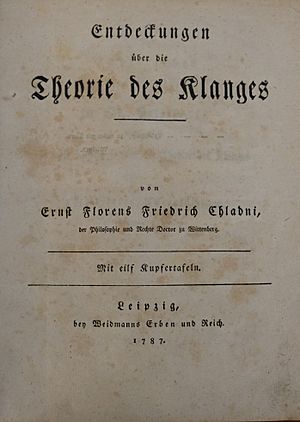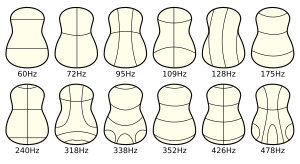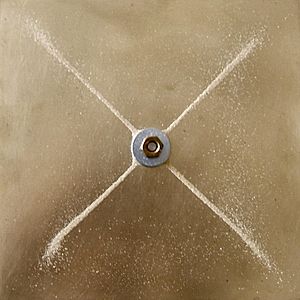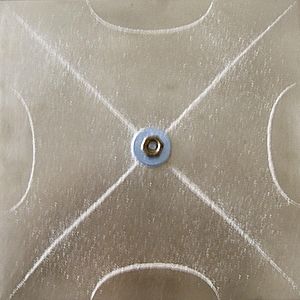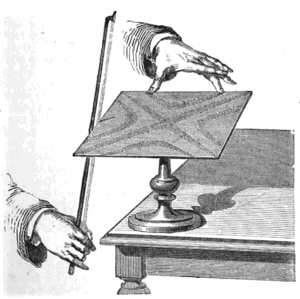Ernst Chladni facts for kids
Quick facts for kids
Ernst Chladni
|
|
|---|---|
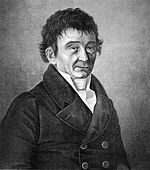
Ernst Chladni
|
|
| Born | 30 November 1756 Wittenberg, Saxony
|
| Died | 3 April 1827 (aged 70) |
| Nationality | German |
| Known for |
|
| Scientific career | |
| Fields | Physics |
| Institutions | University of Erlangen, University of Leipzig |
| Doctoral advisor | Georg Christoph Lichtenberg |
| Doctoral students | Ernst Heinrich Weber |
Ernst Florens Friedrich Chladni (born November 30, 1756 – died April 3, 1827) was a German scientist and musician. He is often called the "father of acoustics" because of his important work. Acoustics is the study of sound.
Chladni studied how things vibrate and how fast sound travels through different gases. He also did amazing work on meteorites. Many people see him as the "father of meteoritics", which is the study of meteorites.
Contents
Early Life and Education
Ernst Chladni was born in Wittenberg, Germany. His family came from a town called Kremnica, which is now in Slovakia. Because of this, some people consider him German, Hungarian, or Slovak.
Chladni grew up in a family of smart and educated people. His great-grandfather and grandfather were both Lutheran theologians and professors. His uncles were also professors, teaching law and history.
Chladni's father, Ernst Martin Chladni, was a law professor and the head of the University of Wittenberg. Ernst was an only child. His father wanted him to become a lawyer and did not like his interest in science.
Career Path
Chladni studied law and philosophy in Wittenberg and Leipzig. He earned a law degree in 1782. That same year, his father passed away. This allowed Chladni to follow his true passion: physics.
From 1783 to 1792, he taught law, math, and science at the University of Wittenberg. During this time, he started his first experiments with sound.
Discovering Chladni Figures
One of Chladni's most famous discoveries was a way to see how surfaces vibrate. These patterns are now called Chladni figures or Chladni patterns. When a flat surface vibrates, it creates areas that move in opposite directions. There are also lines where there is no movement at all. These are called nodal lines.
Chladni was inspired by earlier experiments by Robert Hooke in 1680. Hooke used a violin bow on a glass plate covered with flour to see vibration patterns.
Chladni's method was first shared in his 1787 book, "Discoveries in the Theory of Sound". He would sprinkle sand on a metal plate. Then, he would draw a violin bow along the edge of the plate. When the plate vibrated at a certain sound frequency, the sand would move. It would gather along the nodal lines, showing the amazing patterns.
In 1808, Chladni showed his vibrating patterns to scientists and even Napoleon in Paris. Napoleon was so impressed that he offered a prize for the best mathematical explanation of these patterns. A brilliant mathematician named Sophie Germain was the only one who came close to solving it.
Today, variations of Chladni's technique are still used. They help in designing and building musical instruments like violins and guitars. Modern methods often use a loudspeaker to create precise vibrations.
In quantum mechanics, Chladni figures are similar to how electrons move around an atom. Scientists like Erwin Schrödinger used the math behind these patterns to understand electron orbitals.
| Chladni figures |
|---|
    |
    |
    |
    |
    |
    |
Inventing Musical Instruments
Before Chladni, people enjoyed a musical instrument called a Glasspiel. It was made by filling beer glasses with different amounts of water. You would hit them with mallets to make music.
In 1762, Benjamin Franklin created his own version, the glass armonica. This instrument inspired Chladni to invent two of his own. In 1791, he created the euphon, which used glass rods to make sounds. The euphon is an ancestor of the modern Cristal Baschet. In 1799, Chladni also improved an older instrument to create the clavicylinder.
Chladni traveled all over Europe, showing off his unique musical instruments.
Understanding Meteorites
Chladni became very interested in meteorites after talking to a scientist named Georg Christoph Lichtenberg. Lichtenberg claimed to have seen a bright fireball in the sky in 1791.
This made Chladni research other reports of fireballs and falling rocks across Europe and North America. He noticed that all these sightings were very similar. He concluded that fireballs and falling rocks were real events.
In 1794, Chladni published a book where he suggested that meteorites come from outer space. He argued that this would explain why they fall so fast and glow brightly as they enter Earth's atmosphere. He thought meteorites might be pieces of material that never formed into planets. Or, they could be debris from planets that broke apart.
At the time, this idea was very controversial. Most people believed meteorites came from volcanoes on Earth. Also, it was thought that space beyond the moon was empty, except for other stars and planets. Chladni's ideas challenged these beliefs.
At first, other scientists, including Lichtenberg, made fun of Chladni's book. But his ideas sparked curiosity. Soon, more researchers began to support his theory.
In 1795, a large stony meteorite fell in England. A piece of it, called the Wold Cottage meteorite, was studied by scientists. They found it looked like other meteorites from space. In 1803, a French scientist named Jean Baptiste Biot investigated a meteor shower in France. His report helped convince even more people that Chladni's ideas were correct.
Because of his groundbreaking work, some people call Chladni the "father of meteoritics."
Chladni continued to collect reports of meteorite sightings and gather meteorite samples. In 1827, he gave his collection to a museum in Berlin, where it is still kept today. A mineral found in a meteorite in 1993 was named chladniite in his honor.
Other Scientific Work
Chladni also discovered Chladni's law. This is a simple math rule that helps predict the natural vibration frequencies of plates and other objects.
He also figured out how fast sound travels through different gases. He did this by putting gases into an organ pipe and measuring the sounds it made. This built on earlier work by Pierre Gassendi in 1635.
Death
Ernst Chladni died on April 3, 1827, in Breslau, which is now a city in southwestern Poland.
See also
 In Spanish: Ernst Chladni para niños
In Spanish: Ernst Chladni para niños
- Bessel functions
- Hans Jenny (cymatics)
- Alexander Lauterwasser, a photographer who uses Chladni's work when creating images of liquid surfaces
- Tritare, a guitar causing particular forms of Chladni figures
- Vibrations of a circular membrane



